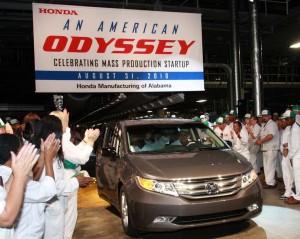Nearly seven in 10 of the Japanese-badged cars, trucks and crossovers sold in the U.S. last year were produced on a North American assembly line, according to a new report.
More than a quarter century after the first Japanese transplant – a Honda factory in Marysville, Ohio – went into operation more than 400,000 jobs in the U.S. have been created by the Japanese, according to a new report by the Japanese Automobile Manufacturers Association, or JAMA.
And that trend could continue. With the yen stronger than ever, manufacturers like Toyota, Nissan and Honda are steadily shifting production away from the home islands. Within the last several months Toyota has announced plans to begin producing several product lines, including the Sienna minivan, in the U.S. for export to Korea. They had previously been produced in Japan.
The JAMA report reveals that Japanese exports from their U.S. plants have been rising rapidly. They jumped to 145,000 in 2010 from just 95,000 the year before. The figures are likely to be down for 2011, according to industry experts, reflecting the impact of the Japanese earthquake and tsunami on global production by makes like Toyota and Honda – whose factories were slammed by ongoing parts shortages for much of the year.
But the trend is expected to continue favoring U.S. and Canadian operations – as well as Mexico, which has become a favored production base for small cars like the Honda Fit. Honda last month announced plans to add a new factory in Mexico to produce the smallest model it sells in North America.
The shift to a North American production base reflects a variety of factors:
- The strong yen has made it extremely difficult to turn a profit on products exported from Japan. At the same time, the weak U.S. dollar has sharply reduced the effective cost of producing vehicles in the States for export;
- Japanese makers have become increasingly aware of political concerns over the American trade deficit. They want to avoid a return of the so-called “voluntary” quotas they faced two decades ago sharply limiting their sales in the U.S.;
- The quality of American-made cars now rivals that of the best Japanese-made vehicles, and as a result, U.S. buyers no longer care where a Toyota, Nissan or Honda – or a Volkswagen or BMW, for that matter – are assembled/
Until recently, the Japanese used American plants primarily to produce their lower-cost models, like Nissan’s midsize Sentra, which are more vulnerable to the profit-sapping impact of lopsided exchange rates. But more and more high-line models — like the new JX crossover, which will be sold by Nissan’s Infiniti division – are being shifted to the States, as well.
Some of the more high-tech vehicles, such as the Toyota Prius, continue to be built in Japan, but Nissan will open an extension of its Smyrna, Tennessee assembly plant late this year that will be capable of producing several 100 thousand Leaf battery-electric vehicles annually.
In all, notes JAMA, Japanese automakers had 29 plants operating in the U.S. in 2010 – for a collective investment of $34 billion. More are coming, including the new Toyota line in Tupelo, Mississippi. These factories directly employ about 50,000 workers. And that doesn’t include the spin-off effect at various suppliers and contractors serving those factories.
Still, acknowledged the report, the bulk of the 407,000 jobs are at Japanese automotive dealerships in the U.S. which, according to industry data, typically employ at least 50 Americans apiece.


Just out of curiosity, I wonder how many of the 400,000 jobs “created” by the Japanese have been at the expense of higher-paying jobs in the “Detroit” auto industry. I’m not against new jobs and new employment opportunities in the U.S. by any means, but considering the thousands of jobs, perhaps hundreds of thousands of jobs lost by the Detroit automakers over the same years as the Japanese have gathered strength in the Americas, I do wonder if there has indeed been 400,000 net new jobs in America, as the JAMA folks are more than happy to suggest. And, among the factors suggested for the shift to North American auto production by foreign interests, I feel there is an important one not listed: the fact that North America is slowly but surely becoming a low-wage, non-unionized mecca for manufacturing, especially as older workers retire and are replaced in lesser numbers and at lesser pay and benefits by younger counterparts. Yes, I’m glad that the Japanese are providing new employment opportunities in the U.S. By the same token, JAMA needs to be more upfront about where the opportunities are and the compensation provided. I’ll be more convinced the Japanese are on the track to leveling competition when they build a plant somewhere other than in the South or in a state with a governor standing behind right-to-work legislation or one trying to “deep-six” collective bargaining.
You raise a variety of interesting positions. One question that could have been raised in the story were it a longer analysis than basically straight reportage is the issue of repatriation of profits. Does a billion dollars generated by sales at a company HQ’d in Tokyo do the same for the country as a billion in revenues for one of the Detroit makers. Of course, one could also argue that without the transplants a lot more jobs would have fled offshore. The auto industry is one of the rare instances where manufacturing has actually returned to the U.S. And one could also suggest that while the transplants might have driven down auto wages they have also, in turn, helped hold down costs to buyers while also encouraging the push to better quality from the domestics.
It is a complex subject that justifies a nice piece in the New Yorker or Atlantic. Anyone want to assign that freelance piece?
Paul A. Eisenstein
Publisher, TheDetroitBureau.com